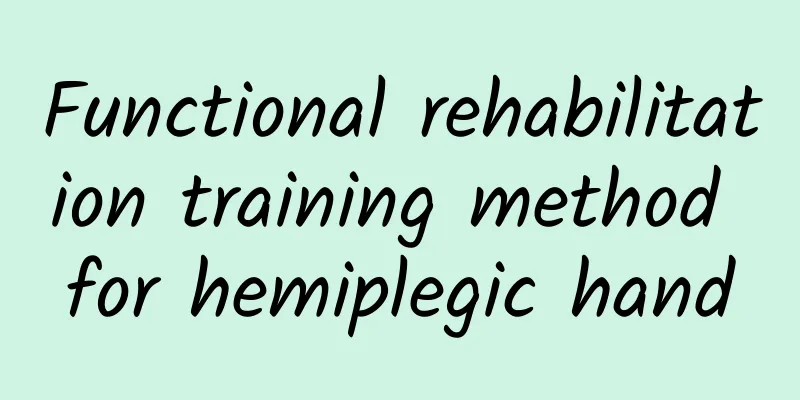Functional rehabilitation training method for hemiplegic hand

|
Under normal circumstances, the recovery of hand function is slower than that of other parts, so comprehensive activities need to be mobilized during rehabilitation training, including not only passive activities but also active activities in the supine position and sitting position, for the best effect. 1. Passive activities The recovery of active movement of hemiplegic upper limbs is relatively slow, so it is very necessary to give patients passive movement training at an early stage. Early passive activities can transmit relevant information about the affected limb to the brain, which can better promote the functional reorganization of the brain and accelerate the recovery of the affected limb function. Passive motion can also prevent the occurrence of the hemiplegic upper limb problems mentioned above, and can also prevent the hemiplegic upper limb from developing a typical spastic pattern. Here are some simple and practical passive activity methods: ⑴ Supine shoulder external rotation and arm elevation l The patient lies supine with the affected leg flexed and the knee erect (without internal or external rotation of the hip) l Lift the patient's affected arm, straighten the elbow, and raise it above the head, while moving the shoulder girdle forward Then open the patient's hand, spread the fingers, and separate the thumb from the four fingers. ⑵ Lateral position lift l Patient lying on the healthy side l Extend your upper limbs and raise them upward, with your shoulders externally rotated l Palms facing the head of the bed, thumbs pointing behind you The therapist holds the patient's hand in a handshake manner, with the patient's thumb on the outside and the patient's wrist tilted upward (dorsiflexion) ⑶Scapula movement in side-lying position l Patient lying on the healthy side The therapist places one hand on the patient's affected shoulder blade and uses the other hand and forearm to support the patient's upper limb and rotate the shoulder outward and extend it forward. l The therapist then moves the patient's affected shoulder blade forward and backward 2. Active movement in the supine position Once the patient has regained some muscle function, he should be asked to begin active range of motion exercises. But be sure to start with small-scale, low-strenuous activities to avoid triggering unnecessary muscle activity in other parts of the body. At the beginning, the therapist should provide full help and then gradually reduce the amount of assistance when the patient makes progress. ⑴Recommendation activities The therapist stands on the patient's affected side, holds the patient's elbow with one hand to straighten the affected elbow, and uses the other hand to cross the ten fingers of the patient's affected hand (with the patient's thumb on the outside), and presses the patient's upper limb at the heel of the palm. Raise the patient's affected upper limb 90°, with the wrist dorsiflexed and the palm facing up. Ask the patient to push the therapist's hand, which is pressed on the heel, straight up. Be careful not to lift the patient's shoulders and head. ⑵Elbow flexion and extension The therapist holds the patient's affected upper arm with one hand to keep it flexed at 90°, and holds the patient's affected hand with the other hand. Ask the patient to straighten his elbow and touch the therapist's forehead with his hand. Then, have the patient slowly place his hand on the unaffected shoulder. Then ask the patient to straighten his elbow and touch the therapist's forehead with his hand again. Practice this repeatedly. Note that during the entire process, the patient's hands should be relaxed and the fingers should be spread as wide as possible. ⑶Holding and placing in the air The therapist places the patient's upper limbs in a certain position and asks the patient to remain suspended in this position (holding training). Make sure the patient's elbow is straight and fingers are spread as wide as possible. When the therapist can place the patient's upper limbs in any position and the patient can maintain it, the patient can be asked to actively place the affected limbs in various positions (placement training). But make sure the patient's elbow is straight and the fingers of the affected hand are open. 3. Active sitting ⑴ Lateral weight bearing on the affected upper limb The patient sits beside the bed. The affected hand is supported at the side with the fingers spread out. Have the patient shift their weight onto the affected hand and push the elbow into extension. If the patient is able to keep the elbow in an extended position for a period of time, the patient can be asked to do elbow flexion and extension exercises in this position. ⑵ Forearm supination The patient sits upright and places his hands on the table in front of him, palms facing each other. The patient then rotates both forearms outward so that the palms face upward. Teach the patient to use the affected hand to imitate the movements of the healthy hand. (Note that the fingers of both hands should be spread out, with the thumb separated from the other four fingers. If the patient's affected hand cannot complete the rotation, the patient can cross the fingers of both hands and use the healthy hand to help the affected hand so that the palm of the affected hand faces up. |
<<: What are the symptoms of chlamydia infection?
>>: What are the harms of gastroscopy?
Recommend
Small blisters on hands hurt when touched
Everyone's skin reacts differently to the ext...
My period was delayed for a few days.
Everyone has a few days of menstruation during wh...
What should pregnant women do if they have pharyngitis? What should we pay attention to?
During the pregnancy stage, pregnant women's ...
Is liver cancer contagious?
We know that hepatitis B is contagious, and if he...
What causes a slow heart rate?
The main cause of bradycardia is sinus bradycardi...
Effects of eating oysters for men at night
For men, eating some oysters regularly is very be...
What to do if there is a hole in the tooth
Eat fried chicken, drink beer, eat spicy crayfish...
How to effectively treat involuntary movement cerebral palsy
Involuntary movement type cerebral palsy is also ...
Why do I often get bruises on my body?
Some women often get bruises on their bodies, whi...
How to know if you are infected during sheep biopsy
Amniocentesis is a relatively common examination ...
Children's lung-clearing recipes, choose these three most reliable
For parents, when they prepare menus for children...
What is the effect of Artemisia annua plus red dates
What are the effects of Artemisia annua and red d...
What are breast particles?
Normal female friends have smooth and flat breast...
Gynecological examination of bacteria
If miscellaneous bacteria are detected during a g...
What medicine to take for enteritis during lactation
The lactation period is the time when a woman has...









